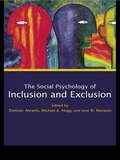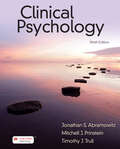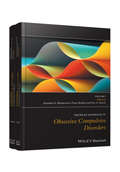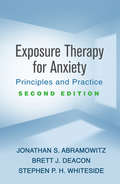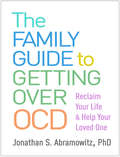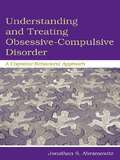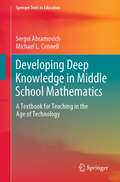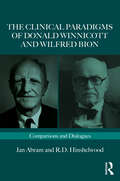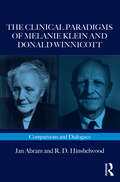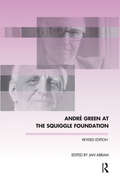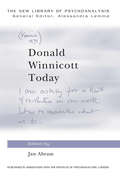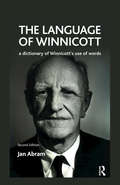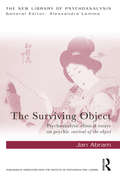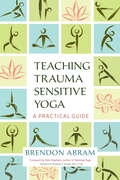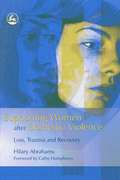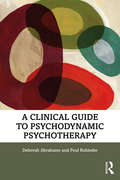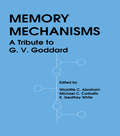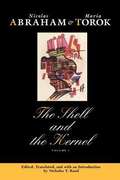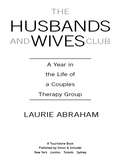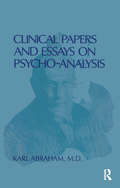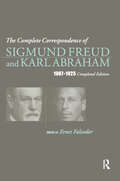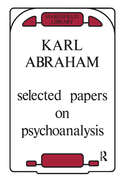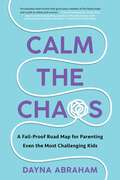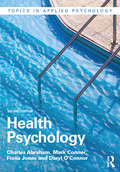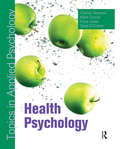- Table View
- List View
Social Psychology of Inclusion and Exclusion
by Dominic Abrams Michael A. Hogg José M. MarquesThis book is about the social psychological dynamics and phenomenology of social inclusion and exclusion. The editors take as their starting point the assumption that social life is conducted in a framework of relationships in which individuals seek inclusion and belongingness. Relationships necessarily include others, but equally they have boundaries that exclude. Frequently these boundaries are challenged or crossed. The book will draw together research on individual motivation, small group processes, stigmatization and intergroup relations, to provide a comprehensive social psychological account of social inclusion and exclusion.
Clinical Psychology: A Scientific, Multicultural, and Life-Span Perspective
by Jonathan S. Abramowitz Mitchell Prinstein Timothy TrullThe ideal brief introduction to the science and practice of clinical psychology in today’s world.
The Wiley Handbook of Obsessive Compulsive Disorders (Wiley Clinical Psychology Handbooks)
by Jonathan S. Abramowitz Dean McKay Eric A. StorchThe Wiley Handbook of Obsessive Compulsive Disorders, 2 volume set, provides a comprehensive reference on the phenomenology, epidemiology, assessment, and treatment of OCD and OCD-related conditions throughout the lifespan and across cultures. Provides the most complete and up-to-date information on the highly diverse spectrum of OCD-related issues experienced by individuals through the lifespan and cross-culturally Covers OCD-related conditions including Tourette’s syndrome, excoriation disorder, trichotillomania, hoarding disorder, body dysmorphic disorder and many others OCD and related conditions present formidable challenges for both research and practice, with few studies having moved beyond the most typical contexts and presentations Includes important material on OCD and related conditions in young people and older adults, and across a range of cultures with diverse social and religious norms
Exposure Therapy for Anxiety, Second Edition: Principles and Practice
by Jonathan S. Abramowitz Brett J. Deacon Stephen P. WhitesideNow revised and expanded to include cutting-edge acceptance-based techniques and a new focus on inhibitory learning, this is the leading guide to therapeutic exposure, a crucial element of evidence-based psychological treatments for anxiety. The book helps the clinician gain skills and confidence for implementing exposure successfully and tailoring interventions to each client's needs, regardless of diagnosis. The theoretical and empirical bases of exposure are reviewed and specialized assessment and treatment planning techniques described. User-friendly features include illustrative case examples, sample treatment plans, ideas for exercises targeting specific types of fears, and reproducible handouts and forms that can be downloaded and printed in a convenient 8½" x 11" size. New to This Edition *Chapter on acceptance and commitment therapy (ACT) techniques. *Reflects a shift in the field toward inhibitory learning--helping clients learn to tolerate anxiety and uncertainty to maximize long-term outcomes. *Chapter on uses of technology, such as computer-based therapy and virtual reality tools. *Conceptual, empirical, and clinical advances woven throughout.
The Family Guide to Getting Over OCD: Reclaim Your Life and Help Your Loved One
by Jonathan S. AbramowitzWhen a loved one has OCD, it's a constant struggle. It hurts to see your spouse so anxious or your teen spending so much time alone. You've tried logic, reassurance, even accommodating endless rituals--but, too often, these well-meaning attempts actually make OCD worse. Psychologist Jonathan Abramowitz has worked with countless families affected by OCD, and he understands the strain. He also knows you can turn things around. Grounded in state-of-the-art treatment research, this compassionate guide helps you change your own behavior to support your loved one's recovery. By gently but firmly encouraging the person you care about to face their fears, you can stop being controlled by the disorder, disentangle yourself from unhealthy patterns, and see your whole family grow more confident and hopeful. Vivid stories, dos and don'ts, and practical tools (which you can download and print for repeated use) help you follow the step-by-step strategies in this life-changing book.
Understanding and Treating Obsessive-Compulsive Disorder: A Cognitive Behavioral Approach
by Jonathan S. AbramowitzAmong the most prevalent and personally devastating psychological disorders the development of a cognitive approach to obsessive compulsive disorder (OCD) has transformed our understanding and treatment of it. In this highly practical and accessible book, Jonathan Abramowitz presents a model of OCD grounded in the most up-to-date research that incorporates both cognitive and behavioral processes. He then offers a step-by-step guide to psychological treatment that integrates psychoeducation, cognitive techniques, and behavioral therapy (exposure and response prevention). Unlike other manuals for the treatment of OCD, this book teaches the reader how to tailor the choice of techniques and delivery modes for individuals presenting with a wide range of specific OCD symptoms, such as contamination fears and cleaning rituals, fears of harm and compulsive checking, symmetry and ordering, and severe obsessions with mental rituals. The techniques are illustrated with numerous case examples; clinical forms and handouts are provided for use with patients. A final chapter suggests strategies for overcoming common obstacles in treatment.
Developing Deep Knowledge in Middle School Mathematics: A Textbook for Teaching in the Age of Technology (Springer Texts in Education)
by Sergei Abramovich Michael L. ConnellThis textbook is for prospective teachers of middle school mathematics. It reflects on the authors’ experience in offering various mathematics education courses to prospective teachers in the US and Canada. In particular, the content can support one or more of 24-semester-hour courses recommended by the Conference Board of the Mathematical Sciences (2012) for the mathematical preparation of middle school teachers. The textbook integrates grade-appropriate content on all major topics in the middle school mathematics curriculum with international recommendations for teaching the content, making it relevant for a global readership. The textbook emphasizes the inherent connections between mathematics and real life, since many mathematical concepts and procedures stem from common sense, something that schoolchildren intuitively possess. This focus on teaching formal mathematics with reference to real life and common sense is essential to its pedagogical approach. In addition, the textbook stresses the importance of being able to use technology as an exploratory tool, and being familiar with its strengths and weaknesses. In keeping with this emphasis on the use of technology, both physical (manipulatives) and digital (commonly available educational software), it also explores e.g. the use of computer graphing software for digital fabrication. In closing, the textbook addresses the issue of creativity as a crucial aspect of education in the digital age in general, and in mathematics education in particular.
The Clinical Paradigms of Donald Winnicott and Wilfred Bion: Comparisons and Dialogues (Routledge Clinical Paradigms Dialogue Series)
by Jan Abram Robert D. HinshelwoodThis book introduces the psychoanalytic principles of both Winnicott and Bion, to compare the ways in which their concepts evolved, and to show how their different approaches contribute to distinctive psychoanalytic paradigms that warrant further research. The book is comprised of five parts, each of which ends with a dialogue between authors, to provide an in-depth look at the perspectives of Winnicott and Bion on the following issues: the British Psychoanalytical Society; working with children and groups; the formulation of psychoanalytic principles; the consolidation of their ideas and new beginnings; and their clinical approaches. Structuring an analysis of Winnicott and Bion’s work in this way simultaneously acts as a comprehensive introduction to their thinking and provokes further research into the ways in which the Winnicottian and Bionian traditions interact. The Clinical Paradigms of Donald Winnicott and Wilfred Bion will appeal to all those seeking an introduction to psychoanalytic ideas and to these two schools of British Object Relations especially.
The Clinical Paradigms of Melanie Klein and Donald Winnicott: Comparisons and Dialogues (Routledge Clinical Paradigms Dialogue Series)
by Jan Abram R.D. HinshelwoodThe Clinical Paradigms of Melanie Klein and Donald Winnicott seeks to introduce the distinctive psychoanalytic basic principles of both Klein and Winnicott, to compare and contrast the way in which their concepts evolved, and to show how their different approaches contribute to distinctive psychoanalytic paradigms. The aim is twofold – to introduce and to prompt research. The book consists of five main parts each with two chapters, one each by Abram and Hinshelwood that describes the views of Klein and of Winnicott on 5 chosen issues: Basic principles Early psychic development The role of the external object The psychoanalytic concept of psychic pain Conclusions on divergences and convergences Each of the 5 parts will conclude with a dialogue between the authors on the topic of the chapter. The Clinical Paradigms of Melanie Klein and Donald Winnicott will appeal to who are being introduced to psychoanalytic ideas and especially to both these two schools of British Object Relations.
Andre Green at the Squiggle Foundation
by Jan AbramDespite being one of the foremost psychoanalysts working today, much of Andre Green's work has until recently been unavailable in English. This work aims to rectify this, by collecting together five lectures given to the Squiggle Foundation in London. This accessible and clearly written book provides a unique introduction to Green's work and its relation to the work of D.W. Winnicott, as promoted by the Squiggle Foundation itself. The Squiggle Foundation has as its goal "to study and cultivate the tradition of D.W. Winnicott", and has achieved an international reputation in doing so. Dr Green's lectures touch particularly on the links between his thought and that of Winnicott - as can be seen from the lecture titles: "Experience and Thinking in Analytic Practice", "Objects(s) and Subject", "On Thirdness", "The Posthumous Winnicott: On Human Nature", and "The Intuition of the Negative Playing and Reality".
Donald Winnicott Today (The New Library of Psychoanalysis)
by Jan AbramWhat in Winnicott’s theoretical matrix was truly revolutionary for psychoanalysis? In this book, the editor and contributors provide a rare in-depth analysis of his original work, and highlight the specifics of his contribution to the concept of early psychic development which revolutionised the theory and practice of psychoanalysis. Including re-publications of selected Winnicott papers to set the scene for the themes and explorations in subsequent chapters, the book examines how Winnicott expanded Freud’s work, and how his discourse with Melanie Klein sharpened his thought and clinical innovations. Divided into 3 sections, it covers: Introductory overviews on the evolution of Winnicott’s theoretical matrix Personal perspectives from eminent psychoanalysts on how Winnicott’s originality inspired their own work Further recent examinations and extensions including new findings from the archives Drawing on her own extensive knowledge of Winnicott and the expertise of the distinguished contributors, Jan Abram shows us how Winnicott’s contribution constitutes a major psychoanalytic advance to the concept of subjectivity. As such, it will be an inspiration to experienced psychoanalysts, psychotherapists and all those interested in human nature and emotional development.
The Language of Winnicott: A Dictionary of Winnicott's Use of Words
by Jan AbramThe author's lexicon - The Language of Winnicott - has proved to be the definitive comprehensive guide to Winnicott's thought since it was first published in 1996, Winnicott's centenary Year. The twenty-two entries represent the major conceptualisations in Winnicott's theories and take the reader on a journey through his writings that span from 1931 to 1971. Thus the volume is an anthology of Winnicott's writings. This new edition expands on each original entry predicated on the author's research discoveries, including archival material, over the past decade.
The Surviving Object: Psychoanalytic clinical essays on psychic survival-of-the-object (New Library of Psychoanalysis)
by Jan AbramIn this book, Abram proposes and elaborates the dual concept of an intrapsychic surviving and non surviving object and examines how psychic survival-of-the-object places the early m/Other at the centre of the nascent psyche before innate factors are relevant. Abram’s clinical-theoretical elaborations advance several of Winnicott’s key concepts. Moreover, the clinical illustrations show how her advances arise out of the transference-countertransference matrix of the analyzing situation. Chapter by chapter the reader witnesses the evolution of her proposals that not only enhance an appreciation of Winnicott’s original clinical paradigm but also demonstrate how much more there is to glean from his texts especially in the contemporary consulting room. The Surviving Object comprises 8 chapters covering themes such as: the incommunicado self; violation of the self; the paradox of communication; terror at the roots of non survival; an implicit theory of desire; the fear of WOMAN underlying misogyny; the meaning of infantile sexuality; the ‘father in the nursing mother’s mind’ as an ‘integrate’ in the nascent psyche; formlessness preceding integration; a theory of madness. The volume will appeal to psychoanalysts and psychoanalytically-informed psychotherapists of all levels who are inspired by clinical psychoanalysis and the study of human nature.
Teaching Trauma-Sensitive Yoga: A Practical Guide
by Brendon Abram Mark Stephens Margaret A. HowardA practical, hands-on, experienced-based guide from a military veteran turned yoga teacherBrendon Abram combines his first-hand experience with PTSD in the field and years of teaching to offer this practical guide to bringing trauma-sensitive yoga to both clinical and studio settings. Drawing on his work with military veterans, first responders, and survivors of domestic and sexual abuse, he emphasizes the importance of respecting the uniqueness of every individual and demonstrates how to use the foundational principles of yoga to create a safe experience. Abram explains that basic principles of yoga bring power to the practice and that breath, mindful movement, focused awareness, and acceptance of present-moment experience form the foundation of any yoga offering.
Supporting Women after Domestic Violence: Loss, Trauma and Recovery
by Hilary Abrahams Cathy Humphreys'This is really interesting and compelling book. Abrahams' writing style is readable and engaging and is interspersed with reference to research and powerfully, the words of women who have experienced domestic violence. Right from the beginning of this book, there are passages that challenge stereotypes and tackle stereotypical thinking regarding women who experience domestic violence... Very engaging, Really useful. Powerful and authoritative, I'd recommend this book to anyone working with women, whether in the community or the workplace. I have worked with a variety of groups (children, families, people with mental health problems, older people) and domestic violence has been a factor in working in all these areas of work. This text will certainly be useful to me and no doubt to many others addressing issues of domestic violence.' - Well-Being 'Abrahams gives us a sense of how lives are shattered and rebuilt in this compelling book that is the culmination of a research project exploring the experiences of women and children in three refuges in the UK... It is a key resource for those working within women's refuges, as well as for professionals whose work brings them into contact with victims of domestic violence. Those tasked with developing and implementing public policy would also find it enlightening.' - Therapy Today 'Compelling reading for anyone working with women and children living with and leaving domestic violence.' - From the Foreword by Cathy Humphreys Women who leave an abusive relationship often experience feelings of fear, bewilderment, anger and confusion. The trauma caused by domestic violence leaves a legacy that stays with the survivor, and it is not uncommon for women to experience feelings of loss and grief similar to those following bereavement, but made more complex by the effect that abuse has had on their emotional health and well-being. Supporting Women after Domestic Violence offers accessible advice on how to enable women who have experienced domestic violence to embark on a journey of recovery. The book draws on theory, original research and the personal experiences of women who have encountered domestic violence to explore the complex practical and emotional support they need when engaging in the process of recovery. It highlights the difficulties a victim of domestic violence may encounter following an abusive relationship, offers action points to improve service provision, and covers important issues in recovery, such as the value of mutual support and how women can regain a sense of normality and self-esteem. This book will be a key resource for those working within women's refuges, as well as social workers, counsellors, mental health professionals and many others whose work may bring them into situations where domestic violence is an issue.
A Clinical Guide to Psychodynamic Psychotherapy
by Deborah Abrahams Poul RohlederA Clinical Guide to Psychodynamic Psychotherapy serves as an accessible and applied introduction to psychodynamic psychotherapy. The book is a resource for psychodynamic psychotherapy that gives helpful and practical guidelines around a range of patient presentations and clinical dilemmas. It focuses on contemporary issues facing psychodynamic psychotherapy practice, including issues around research, neuroscience, mentalising, working with diversity and difference, brief psychotherapy adaptations and the use of social media and technology. The book is underpinned by the psychodynamic competence framework that is implicit in best psychodynamic practice. The book includes a foreword by Prof. Peter Fonagy that outlines the unique features of psychodynamic psychotherapy that make it still so relevant to clinical practice today. The book will be beneficial for students, trainees and qualified clinicians in psychotherapy, psychology, counselling, psychiatry and other allied professions.
Memory Mechanisms: A Tribute To G.v. Goddard
by Wickliffe C. Abraham Michael Corballis K. Geoffrey WhitePresenting the work of researchers who are at the forefront of the study of memory mechanisms, this volume addresses a wide range of topics including: physiological and biophysical studies of synaptic plasticity, neural models of information storage and recall, functional and structural considerations of amnesia in brain-damaged patients, and behavioral studies of animal cognition and memory. The book's coverage of diverse approaches to memory mechanisms is intended to help dissolve the borders between behavioral psychology, cognitive neuropsychology, and neurophysiology.
The Shell and the Kernel: Renewals of Psychoanalysis, Volume 1
by Nicolas Abraham Maria Torok Nicholas Rant Nicholas Rand<p>This volume is a superb introduction to the richness and originality of Abraham and Torok's approach to psychoanalysis and their psychoanalytic approach to literature. Abraham and Torok advocate a form of psychoanalysis that insists on the particularity of any individual's life story, the specificity of texts, and the singularity of historical situations. In what is both a critique and an extension of Freud, they develop interpretive strategies with powerful implications for clinicians, literary theorists, feminists, philosophers, and all others interested in the uses and limits of psychoanalysis. <p>Central to their approach is a general theory of psychic concealment, a poetics of hiding. Whether in a clinical setting or a literary text, they search out the unspeakable secret as a symptom of devastating trauma revealed only in linguistic or behavioral encodings. Their view of trauma provides the linchpin for new psychic and linguistic structures such as the "transgenerational phantom," an undisclosed family secret handed down to an unwitting descendant, and the intra-psychic secret or "crypt," which entombs an unspeakable but consummated desire. Throughout, Abraham and Torok seek to restore communication with those intimate recesses of the mind which are, for one reason or another, denied expression. <p>Classics of French theory and practice, the essays in volume one include four previously uncollected works by Maria Torok. Nicholas Rand supplies a substantial introductory essay and commentary throughout. Abraham and Torok's theories of fractured meaning and their search for coherence in the face of discontinuity and disruption have the potential to reshape not only psychoanalysis but all disciplines concerned with issues of textual, oral, or visual interpretation.</p>
The Husbands and Wives Club
by Laurie AbrahamA PAGE-TURNING GLIMPSE INTO FIVE MARRIAGES AND THE FIGHT TO SAVE THEMFor more than a year, journalist Laurie Abraham sat in with five troubled couples as they underwent the searing process of group marriage therapy. Published as The New York Times Magazine's cover story "Can This Marriage Be Saved?" the resulting article generated intense reader response and received the Award for Excellence in Journalism from the American Psychoanalytic Association. Though the article allowed Abraham to focus on only one couple, this book, which grew out of it and the reaction it inspired, tells the moving, fascinating story of all five.The couples: Can Leigh and Aaron find the intimacy their marriage lacks; will Bella and Joe resolve the imbalance of power that threatens to topple their marriage; are Sue Ellen and Mark as ideal as they seem; what happened to Rachael that Michael cannot acknowledge; and do Marie and Clem, with the help of therapist Judith Coché, come back from the brink of divorce?With the dexterity of a novelist, Abraham recounts the travails, triumphs, and reversals that beset the five couples. They work with their therapist--and each other--to find out whether they can rediscover the satisfaction in marriage that they once had. At times wrenching, at times inspiring, the sessions bring out the long-hidden resentments, misunderstandings, unmet desires, and unspoken needs that bedevil any imperiled couple. At the same time, these encounters provide road maps to reconciliation and revival that can be used by anyone in a relationship. Along the way, the author draws on her explorations of literature and Freudian theory, modern science, and today's cutting-edge research to decode the patterns and habits that suggest whether a troubled marriage will survive or die. Both an important look at the state of marital dysfunction and a reaffirmation of the enduring bonds of love, The Husbands and Wives Club is an extraordinary year in the life of the American marriage.
Clinical Papers and Essays on Psychoanalysis (Classics In Psychoanalysis Ser.)
by Karl AbrahamThis book is a collection of the works of Dr. Karl Abraham's writings. It covers the sexual trauma in childhood for the symptomatology of dementia praecox, the significance of intermarriage between close relatives in the psychology of the neuroses, psycho-analysis, and a study in folk-psychology.
The Complete Correspondence of Sigmund Freud and Karl Abraham 1907-1925
by Karl AbrahamKarl Abraham was an important and influential early member of Freud’s inner circle of trusted colleagues. As such he played a significant part in the establishment of psychoanalysis as a recognised and respected discipline. Regarded by Ernest Jones as one of the best clinical analysts among his contemporaries1 he also elaborated and expanded upon Freud’s theories. Exploring first-hand the complex relationship and rivalries that existed not only between Freud and his master pupil, but also the details of their combined and individual relationships with Jung, this substantial and absorbing collection of letters enables the reader to gain valuable insights into these two pioneers of psychoanalysis.‘Since psychoanalysis is established as an essential part of the history of ideas for the last century, intellectual historians should relish the fact that an absolutely excellent and full edition of this correspondence has finally come out.’
Selected Papers on Psychoanalysis
by Karl AbrahamCovering a wide range of topics, the collection consists of twenty-six papers and essays published over a period of two decades. Readers of this book are thus enabled to trace the analyst's development, in which his scientific approach is evident throughout, from his earliest papers through to his last works. First published in 1927 in the International Psychoanalytical Library, the author's Selected Papers on Psychoanalysis has since established itself as on of the seminal works essential to the training of workers in the psychoanalytic field. Includes the author's classic paper A Short Study of the Development of the Libido.
Calm the Chaos: A Fail-Proof Road Map for Parenting Even the Most Challenging Kids
by Dayna AbrahamA simple, fail-proof road map for parents raising even the most challenging children from the founder of the life-changing Calm the Chaos methodology and the Lemon Lime Adventures blog.Strong-willed, spirited, explosive, and highly sensitive are just a few of the most common labels for challenging kids. Whether your child has been diagnosed with a behavioral condition, labeled, or is just harder than other children you&’ve met, you are in luck. Parenting expert, Dayna Abraham is here to help. Calm the Chaos is a clearly organized, methodical approach to parenting. Dayna has created a road map to help parents find peace and meet their kids where they are at when conventional parenting tools have failed. There are five steps to calming the chaos—Getting to Safety, Restoring Trust and Energy, Finding Calm in the Moment, Getting Ahead of the Moment, and Defining Family Success. Each step employs a framework that is easy to remember, even when emotions run high: you ground yourself, you connect with your kid, you work with them to understand the catalyst and the issue at the heart, and then together you get curious about finding an empowered solution. Backed by science and tested by hundreds of thousands of families, Calm the Chaos is a revolutionary road map complete with in-the-trenches stories, scripts, prompts, and worksheets that make it simple for parents to build a safe home and support healthy kids.
Health Psychology (Topics in Applied Psychology)
by Charles Abraham Mark Conner Fiona Jones Daryl O'ConnorThe new edition of Health Psychology is the perfect introduction to this rapidly developing field. Throughout the book, the psychological processes that shape health-related behaviours, and affect core functions such as the immune and cardiovascular systems, are clearly explained. These relationships provide the foundation for psychological interventions which can change cognition, perception and behaviour, thereby improving health. The book is split into five sections, and builds to provide a comprehensive overview of the field: the biological basis of health and illness stress and health coping resources: social support and individual differences motivation and behaviour relating to patients Extensively revised to include new material on behavioural change, the role of stress, resilience and social support, recovery from work, and the care of people with chronic disease, the book also includes a range of features which highlight key issues, and engage readers in applying what we have learned from research. This is essential reading for any undergraduates studying this exciting field for the first time, and the perfect primer for those embarking on postgraduate study.
Health Psychology: Critical Concepts In Psychology (Topics in Applied Psychology)
by Charles AbrahamTopics in Applied Psychology offers a range of accessible, integrated texts ideal for courses in applied psychology. The books are written by leading figures in their field and provide a comprehensive academic and professional insight into each topic. They incorporate a range of features to bring psychology to life including case histories, research methods, ethical debate and learner activities. Each chapter opens with learning objectives to consolidate key points. A reading list and sample essay questions at the end of chapters enable further independent study. The series also offers an appreciation of multiple perspectives, examines the relationship between psychology and other cognate disciplines and discusses recent developments in each field. Topics in Applied Psychology will provide you with the tools you need to engage with, enjoy and understand your applied psychology discipline, ultimately ensuring confidence and success in exams as well as a comprehensive grounding in the profession. Health Psychology guides the reader through core issues in health psychology research and practice. Each chapter builds on previous ones so that the text provides an overview of the field rather than presenting a compendium of topics. The book discusses mechanisms, models and methods and examines how biological, cognitive, affective and social processes impact on health and illness. It also explores how stress and coping mechanisms affect health behaviours and the psychological determinants of health behaviour. Two chapters focus on how psychological research can be applied to change health-related attitudes and behaviours. Communication between the patient and practitioner is examined as is the role of the health psychologist. The integrated and interactive approach, combined with the comprehensive coverage, make this book the ideal companion for courses in health psychology.Other books in the series include: Clinical Psychology, Criminal Psychology, Educational Psychology, Organizational and Work Psychology and Sport and Exercise Psychology.
